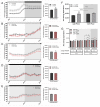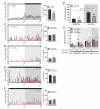Grape Seed Proanthocyanidins Mitigate the Disturbances Caused by an Abrupt Photoperiod Change in Healthy and Obese Rats
- PMID: 35565801
- PMCID: PMC9100649
- DOI: 10.3390/nu14091834
Grape Seed Proanthocyanidins Mitigate the Disturbances Caused by an Abrupt Photoperiod Change in Healthy and Obese Rats
Abstract
Variations in the light/dark cycle and obesogenic diets trigger physiological and behavioral disorders. Proanthocyanidins, in addition to their healthy properties, have recently demonstrated a modulating effect on biological rhythms. Therefore, the aim of this study was to evaluate the administration of a grape seed proanthocyanidin-rich extract (GSPE) to mitigate the disruption caused by a sudden photoperiod change in healthy and cafeteria (CAF)-diet obese rats. For this, 48 photoperiod-sensitive Fischer 344 rats were fed standard or CAF diets for 6 weeks under a standard (12 h light/day, L12) conditions. Then, rats were switched to a long (18 h light/day, L18) or short (6 h light/day, L6) photoperiod and administered vehicle or GSPE (25 mg/kg) for 1 week. Body weight (BW) and food intake (FI) were recorded weekly. Animal activity and serum hormone concentrations were studied before and after the photoperiod change. Hormone levels were measured both at 3 h (ZT3) and 15 h (ZT15) after the onset of light. Results showed the impact of the CAF diet and photoperiod on the BW, FI, activity, and hormonal status of the animals. GSPE administration resulted in an attenuation of the changes produced by the photoperiod disruption. Specifically, GSPE in L6 CAF-fed rats reduced serum corticosterone concentration, restoring its circadian rhythm, increased the T3-to-T4 ratio, and increased light phase activity, while under L18, it decreased BW and testosterone concentration and increased the animal activity. These results suggest that GSPE may contribute to the adaptation to the new photoperiods. However, further studies are needed to elucidate the metabolic pathways and processes involved in these events.
Keywords: cafeteria diet; chrono nutrition; circadian rhythms; phenolic compounds; seasonal rhythms; zeitgebers.
Conflict of interest statement
The authors declare no conflict of interest. The funders had no role in the design of the study; in the collection, analyses, or interpretation of data; in the writing of the manuscript, or in the decision to publish the results.
Figures






Similar articles
-
Grape Seed Proanthocyanidin Extract Attenuates Cafeteria-Diet-Induced Liver Metabolic Disturbances in Rats: Influence of Photoperiod.Int J Mol Sci. 2024 Jul 14;25(14):7713. doi: 10.3390/ijms25147713. Int J Mol Sci. 2024. PMID: 39062955 Free PMC article.
-
Abrupt Photoperiod Changes Differentially Modulate Hepatic Antioxidant Response in Healthy and Obese Rats: Effects of Grape Seed Proanthocyanidin Extract (GSPE).Int J Mol Sci. 2023 Dec 2;24(23):17057. doi: 10.3390/ijms242317057. Int J Mol Sci. 2023. PMID: 38069379 Free PMC article.
-
The effects of grape seed proanthocyanidins in cafeteria diet-induced obese Fischer 344 rats are influenced by faecal microbiota in a photoperiod dependent manner.Food Funct. 2022 Aug 15;13(16):8363-8374. doi: 10.1039/d2fo01206e. Food Funct. 2022. PMID: 35916585
-
Metabolism disturbance by light/dark cycle switching depends on the rat health status: the role of grape seed flavanols.Food Funct. 2023 Jul 17;14(14):6443-6454. doi: 10.1039/d3fo00260h. Food Funct. 2023. PMID: 37377055
-
Photoperiod Conditions Modulate Serum Oxylipins Levels in Healthy and Obese Rats: Impact of Proanthocyanidins and Gut Microbiota.Nutrients. 2023 Jan 30;15(3):707. doi: 10.3390/nu15030707. Nutrients. 2023. PMID: 36771413 Free PMC article.
Cited by
-
Research progress on the regulatory and pharmacological mechanism of chemical components of Dendrobium.Heliyon. 2024 Sep 7;10(18):e37541. doi: 10.1016/j.heliyon.2024.e37541. eCollection 2024 Sep 30. Heliyon. 2024. PMID: 39328574 Free PMC article. Review.
-
Grape Seed Proanthocyanidins Modulate the Hepatic Molecular Clock via MicroRNAs.Mol Nutr Food Res. 2022 Dec;66(23):e2200443. doi: 10.1002/mnfr.202200443. Epub 2022 Oct 26. Mol Nutr Food Res. 2022. PMID: 36189890 Free PMC article.
-
Grape Seed Proanthocyanidin Extract Attenuates Cafeteria-Diet-Induced Liver Metabolic Disturbances in Rats: Influence of Photoperiod.Int J Mol Sci. 2024 Jul 14;25(14):7713. doi: 10.3390/ijms25147713. Int J Mol Sci. 2024. PMID: 39062955 Free PMC article.
-
Functional Characterization and Toxicological Study of Proanthocyanidins in Weaned Pigs.Toxins (Basel). 2023 Sep 7;15(9):558. doi: 10.3390/toxins15090558. Toxins (Basel). 2023. PMID: 37755984 Free PMC article.
-
Grape Polyphenols May Prevent High-Fat Diet-Induced Dampening of the Hypothalamic-Pituitary-Adrenal Axis in Male Mice.J Endocr Soc. 2023 Jul 24;7(9):bvad095. doi: 10.1210/jendso/bvad095. eCollection 2023 Aug 1. J Endocr Soc. 2023. PMID: 37538101 Free PMC article.
References
MeSH terms
Substances
Grants and funding
LinkOut - more resources
Full Text Sources

